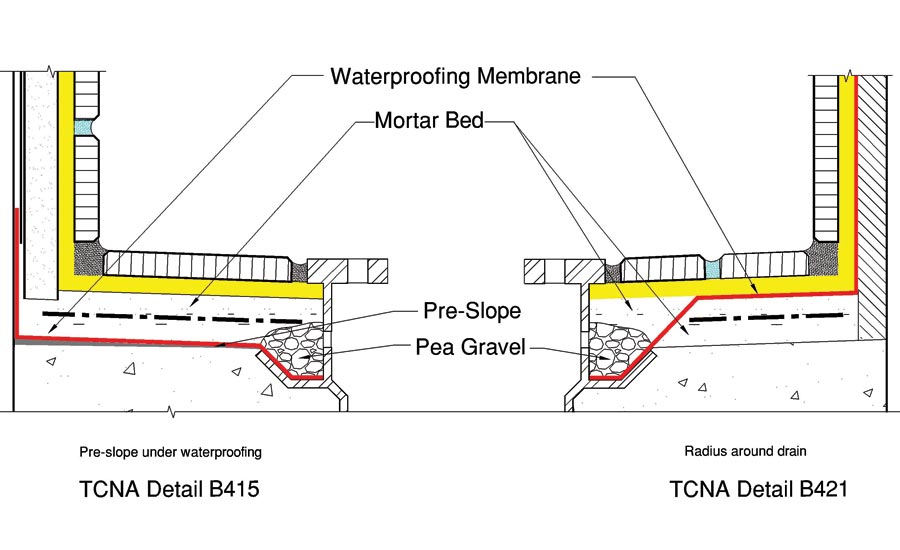Overcoming Challenges When Installing Tile & Stone in Showers










There are a lot of steps involved to properly installing tile in a shower. This is especially true today, when a mixture of tiles including natural stone, glass, mosaics, pebble tiles and large-format porcelain are commonly used together in the same space. Of course, showers must also be waterproofed to protect the building and its occupants. In addition, ceramic tile and stone contractors are constantly pressured to meet tight schedules—while at the same time delivering a fabulous-looking result.
What is the best way to overcome these challenges for a successful shower installation every time?
There are several key installation steps:
- Select a method for forming the shower pan floor. Take into consideration the finished tile elevations at the walls and drain, then create a proper pitch ≥1/4” per foot at the tile surface as well as under the waterproofing membrane.
- Create an absolutely watertight shower pan and ensure that all walls, benches and niches are waterproofed to protect adjoining areas.
- Bond the tile or stone with ≥95% mortar coverage without excessive lippage.
- Grout properly and install a flexible sealant in movement joints.
For the traditional shower pan method using a mortar bed and waterproofing membrane, there are multiple methods accepted by the Tile Council of North America (TCNA). In TCNA Detail B415, a pre-slope of mortar is placed first to create a pitch for the waterproofing membrane or liner. When this mortar dries, the membrane is applied to the pre-slope. Afterwards, the mortar bed is placed and allowed to dry.
In TCNA Detail B421 (see image), the mortar bed is placed on the substrate with a radius around the drain left open in order to tie the waterproofing membrane into the drain collar. When the mortar bed dries, the waterproofing membrane is applied over it and the radius is filled in. In both cases, pea gravel is placed around the drain collar in order to allow water to flow through weep holes.
Based on temperature, humidity and cure rate of the product used, the mortar bed may have to cure for 72 hours prior to installation of the waterproofing membrane. After the membrane is applied, another 24 hours may be required prior to flood testing. Check with the installation material manufacturers for rapid-setting/curing mortars and waterproofing to accelerate the installation schedule.
Once the waterproofing is ready, install the tile or stone with the correct mortar. Technology has really advanced with options for high performance bond strength and deformability that is required for glass and porcelain tiles (ANSI A118.15 Improved Modified Dry-Set Cement Mortar). Many of these mortars are thixotropic and can hold very heavy tiles >10lbs/SF firmly in place without sagging on walls and ceilings.
Natural stone tiles should always be set with white mortar to help prevent darkening. Before choosing a natural stone for a shower, confirm with the supplier that it is suitable for a wet area. Some stones have minerals that could permanently discolor or emit a rust effect. Natural stone suppliers may recommend six-sided application of a penetrating sealer to mitigate these issues. Porous stones such as limestone may take a very long time to dispel moisture from the mortar, so rapid-setting mortars are recommended. When stone is set on a shower floor, pay particular attention to how gravel is placed at the weep holes around the drain, otherwise prolonged moisture and soap scum can cause degradation or discoloration. (See details above.)
To achieve required mortar coverage of 95% in wet areas, using proper trowel sizes, directional combing and back-buttering of large format tile and stone are essential steps. For valuable insight on these methods watch the YouTube video from the National Tile Contractors Association (NTCA).
Completely fill joints with a suitable grout for the tile and conditions and install sealant in movement joints in changes of plane and where required. Grout types and methods of installation are defined by the American National Standards Institute (ANSI). Product characteristics and minimum performance levels are listed in the A118 section; methods of installation in A108. The grout joint is to be finished consistently, packing the grout firmly and to a maximum fill as much as is reasonably possible. This locks the tile in place and helps shed surface water to the drain. Cement-based grouts can be sealed to improve stain resistance. Sealant or caulk is to be placed at all changes of plane instead of grout. The joint below must also be free of mortar in order for the assembly to expand and contract due to expansion from heat and moisture.
Although there are many choices and challenges in shower applications, professional tile installers—especially those with industry recognized training—are up to the task. Training organizations for tile & stone installations include the National Tile Contractors Association 5-Star Members, Tile Contractors Association of America Trowel of Excellence Member, International Masonry Institutes Foreman Certification, and firms that employs Ceramic Tile Education Foundation Certified Installers or recognized by the U.S. Department of Labor as Journeyman Tile Layers.
Installation material manufacturers supply compatible products for the entire system, and when single-sourced, may provide up to a lifetime system warranty. Using integrated systems, including the mortar bed, waterproofing, thin-set mortar and grout, can create a long-lasting installation and meet project schedules. Happy tiling!
Looking for a reprint of this article?
From high-res PDFs to custom plaques, order your copy today!














